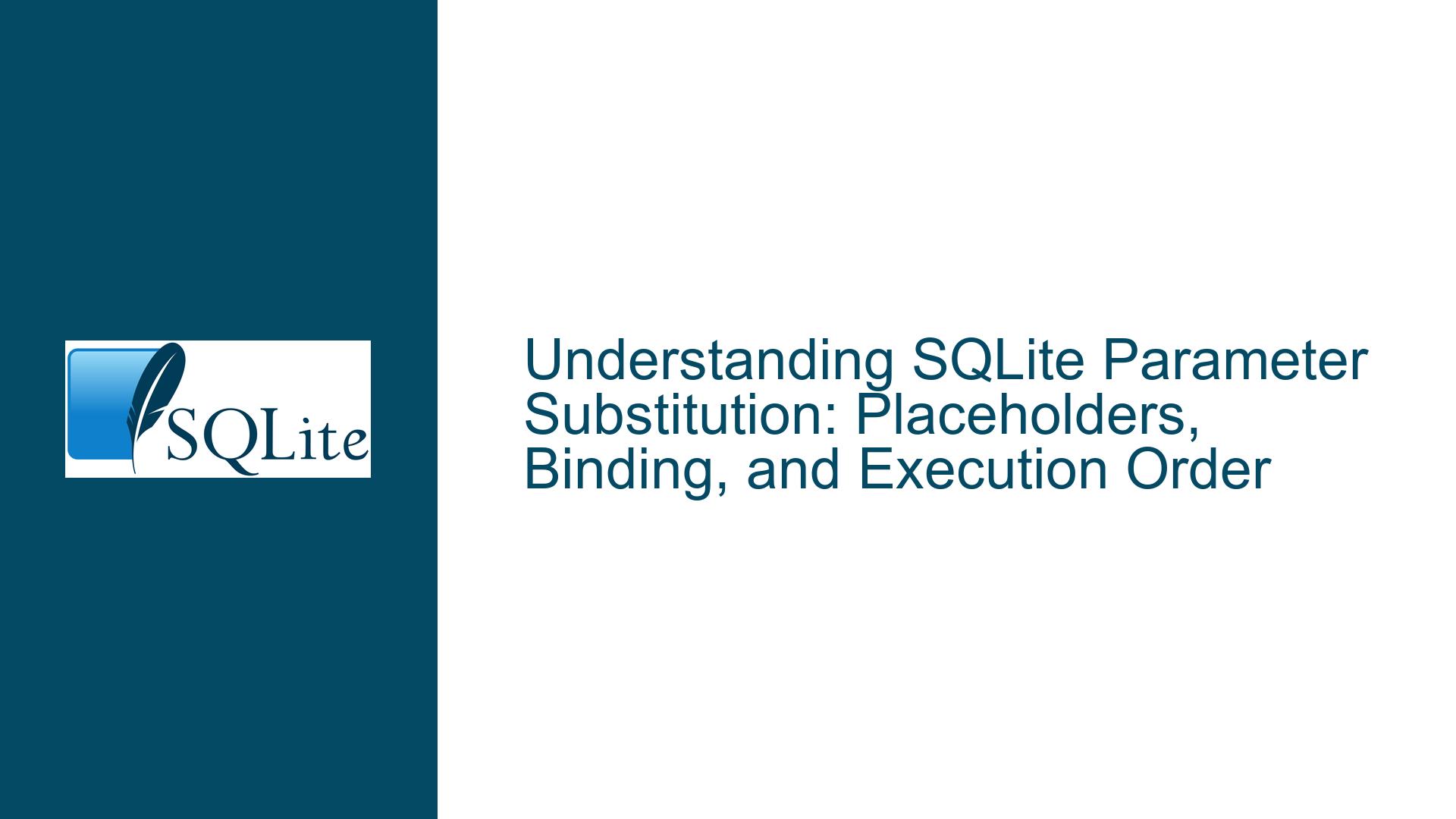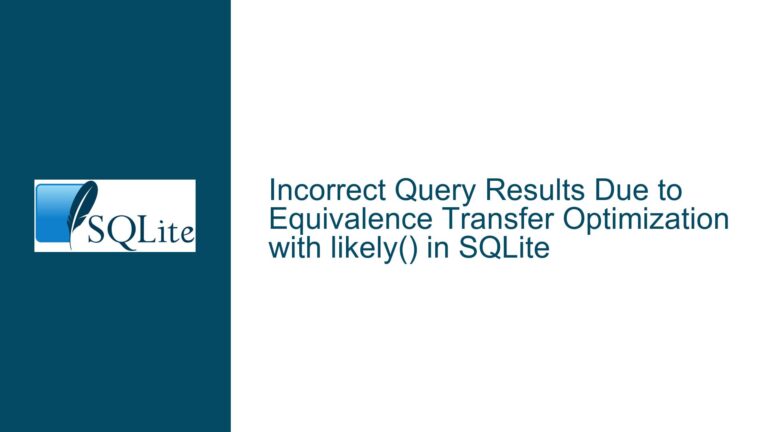SQLite Parameter Substitution: Placeholders, Binding, and Execution Order
Parameter Placeholder Variants and Their Use Cases
SQLite provides multiple ways to specify parameter placeholders in SQL statements, each serving distinct purposes and offering flexibility depending on the context of use. The primary placeholder variants include ?, ?NNN, :VVV, @VVV, and $VVV. These placeholders are not arbitrary; they are designed to accommodate different programming styles, compatibility requirements, and use cases.
The ? placeholder is the simplest form, representing an anonymous parameter. When used, SQLite automatically assigns a sequential index to the parameter, starting from 1. For example, in the statement SELECT ?, ?, the first ? is assigned index 1, and the second ? is assigned index 2. This form is ideal for straightforward queries where the order of parameters is clear and consistent.
The ?NNN placeholder allows explicit specification of the parameter index. For instance, ?3 refers to the third parameter in the statement. This form is useful when the order of parameters in the SQL statement does not align with the order in which they are bound, or when certain parameters need to be reused. For example, in SELECT ?3, ?1, ?2, the parameters are bound in the order 3, 1, 2, regardless of their appearance in the statement.
Named placeholders, such as :VVV, @VVV, and $VVV, provide a way to associate a name with a parameter. These placeholders are functionally equivalent to the ? form but include a name for easier reference. For example, SELECT :name, :age assigns the names :name and :age to the first and second parameters, respectively. Named placeholders are particularly useful in complex queries with many parameters, as they improve readability and maintainability. They also allow for parameter reuse within the same statement, as the same name can refer to the same parameter index.
The choice of prefix symbol (:, @, or $) is largely a matter of convention and compatibility. Different SQL-based systems and programming languages use different symbols for parameter placeholders, and SQLite supports these variations to ensure compatibility. For example, :VVV is commonly used in SQLite and other databases like PostgreSQL, while @VVV is often seen in Microsoft SQL Server, and $VVV is used in some programming languages like PHP.
Parameter Index Allocation and Binding Order
The allocation of parameter indexes in SQLite follows a strict left-to-right order within the SQL statement. The first parameter encountered, whether anonymous or named, is assigned index 1. Each subsequent parameter is assigned an index one greater than the highest index used so far. This rule applies regardless of the placeholder type.
For example, consider the statement SELECT ?47, ?3, ?. Here, the parameters are assigned indexes as follows: ?47 is assigned index 47, ?3 is assigned index 3, and ? is assigned index 48. Note that indexes 1, 2, and 4 through 46 are unused in this statement. This behavior ensures that parameter indexes are allocated predictably, even when explicit indexes are specified.
When binding values to parameters using the sqlite3_bind_* functions, the order of binding does not affect the execution of the statement. All bindings are applied before the statement is executed. For example, if you bind a value to index 3 before binding a value to index 1, it will not cause any issues. However, it is good practice to bind parameters in the order of their indexes to avoid confusion and potential errors.
Named parameters add an additional layer of flexibility. When a named parameter is encountered for the first time, it is assigned the next available index. If the same name is used again in the statement, it refers to the same index. For example, in SELECT :a, ?, ?35, ?2, :a, the parameter :a is assigned index 1, the anonymous ? is assigned index 2, ?35 is assigned index 35, and the second :a refers back to index 1. This allows for parameter reuse without needing to know the exact index.
Best Practices for Parameter Binding and Type Handling
When binding parameters in SQLite, it is crucial to match the data type of the bound value to the appropriate sqlite3_bind_* function. SQLite is dynamically typed, meaning that the type of a value is associated with the value itself, not the column it is stored in. However, using the correct binding function ensures that the value is stored and interpreted correctly.
For example, if you are binding an integer value, use sqlite3_bind_int. If you are binding a text value, use sqlite3_bind_text. Using the wrong function can lead to unexpected behavior. For instance, binding an integer using sqlite3_bind_text would require converting the integer to a string, which is unnecessary and inefficient.
A common mistake is to assume that all parameters can be bound as text. While SQLite will accept text values for numeric columns, this approach can lead to performance issues and subtle bugs. For example, binding the integer 42 as text would result in the string "42", which would need to be converted back to an integer during query execution. This extra conversion step can be avoided by using the appropriate binding function.
Another best practice is to avoid building SQL statements dynamically using string concatenation, especially with user input. This approach is vulnerable to SQL injection attacks, where malicious input can alter the behavior of the query. Instead, always use parameterized queries with placeholders. This not only improves security but also makes the code more readable and maintainable.
For example, instead of:
char query[100];
sprintf(query, "SELECT * FROM users WHERE id = %d;", user_id);
sqlite3_exec(db, query, callback, 0, &errmsg);
Use:
sqlite3_stmt *stmt;
const char *sql = "SELECT * FROM users WHERE id = ?;";
sqlite3_prepare_v2(db, sql, -1, &stmt, 0);
sqlite3_bind_int(stmt, 1, user_id);
sqlite3_step(stmt);
This approach ensures that the user_id value is safely bound to the parameter, preventing SQL injection.
In summary, understanding the nuances of parameter placeholders, index allocation, and binding order is essential for writing efficient and secure SQLite queries. By following best practices and using the appropriate binding functions, you can avoid common pitfalls and ensure that your queries perform as expected.






